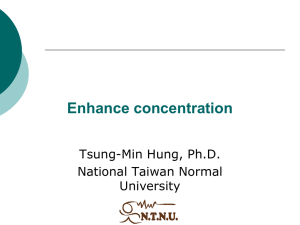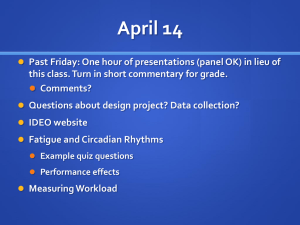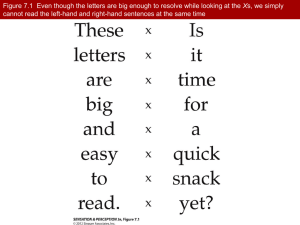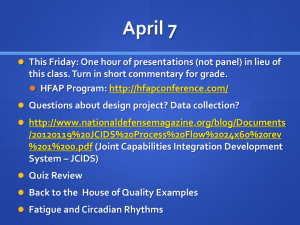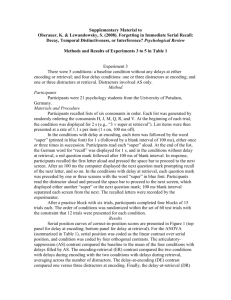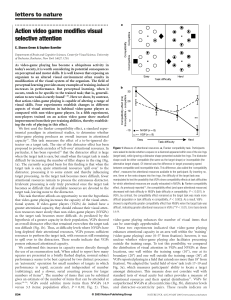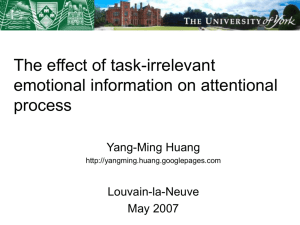Interference from irrelevant color-singletons during serial search
advertisement
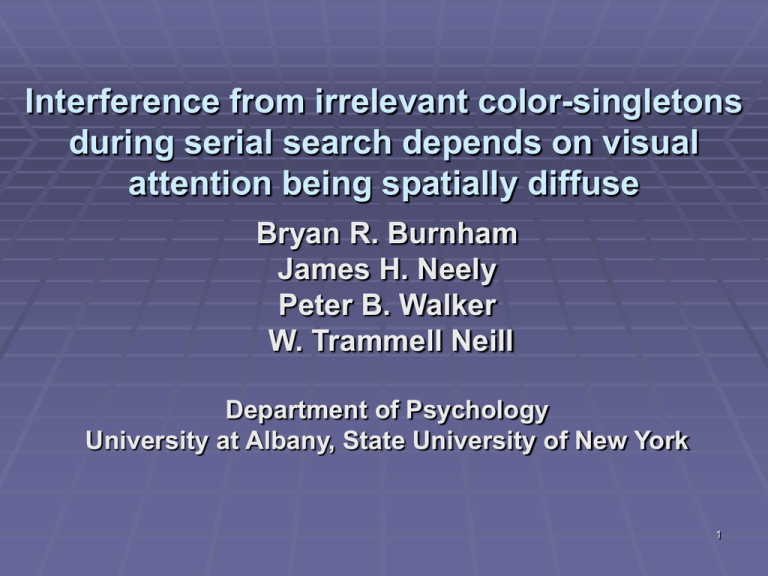
Interference from irrelevant color-singletons during serial search depends on visual attention being spatially diffuse Bryan R. Burnham James H. Neely Peter B. Walker W. Trammell Neill Department of Psychology University at Albany, State University of New York 1 Visual Search Salient, irrelevant stimuli can disrupt visual search Theeuwes (1992) Distractor-Absent Distractor-Present Slower RTs with distractor present Distractor ‘captured’ attention 2 Reasons for Search Disruption Stimulus-Driven Capture of Attention Salience “naturally” captures attention Distractor-Target Feature Association Bacon & Egeth (1994); Folk, Remington & Johnston (1992) Distractor related to Target by “singletoness” ‘Singleton’ Search ‘Feature’ Search 3 No Capture with Feature Search? Theeuwes (2004) Absence of capture not due to feature dissimilarity Feature search displays lower a singleton’s salience Visually Visually “Quieter” “Noisy” 4 If display is visually ‘noisy’ Distractor not perceived as a singleton Serial search adopted Theeuwes (2004) Attentional Window narrows with serial search Focus on one item at a time Distractor cannot be perceived as a singleton No attentional capture during serial search Theeuwes & Burger (1998) No attentional capture during serial search ONLY with strong attentional control Capture found during serial search when attentional control was incomplete 5 Present Study Research shows no attentional capture during serial search when attentional control is strong But, items always in a circular pattern Item-locations repeated and predictable Observers could pre-focus attention With serial search, distractor never perceived as a singleton Will a color singleton capture attention when: A) B) C) D) Serial search is used Strong attentional control is exerted Target is not a singleton Attention is diffuse when display appears 6 Method Two groups searched for ‘A’ vs. ‘R’ Target among 4, 6 or 8 different letters Color singleton on random ½ of trials Relevant and irrelevant colors fixed Groups differed by display configuration: Circle Configuration R H Random Configuration R B K E N H K Z E N S U B U S Z 7 Results No speed-accuracy tradeoff Compared RTs in Distractor Present vs. Absent conditions for each Set Size between groups Configuration x Distractor Presence interaction: 36.5 ms/item* 13.7 ± 12.7 ms* Circle Preset Group: - 4.3 ms/item* 37.5 ± 12.0 ms Random Absent 35.2 ms/item* Random Present 33.2 ms/item* RT (msec) Interference: RT/Item Slopes Circle Random Absent Group: 900 875 850 825 800 775 750 725 700 675 Circle-Absent Circle Present Random-Absent Random-Present 5 7 9 Set Size (Number of Items) 8 Discussion Absence of capture in circular display group Replicates Theeuwes & Burger (1998) Conclusion: Attentional capture Capture in random display groupis possible during serial search Occurred when serialwhen searchattentional was evident control is diffuse strongattention Initially Depends on visual attention being spatially Diffuse attention needed to determine item-locations diffuse when displayasappears Distractor perceived a singleton Overrode strong attentional control “Stimulus-driven” attentional capture? No target-distractor association Capture overrode attentional control 9 The End Contact: 10 bb7090@albany.edu

